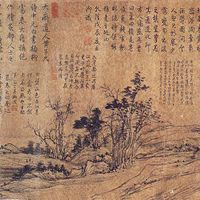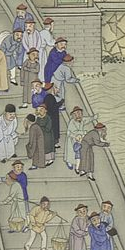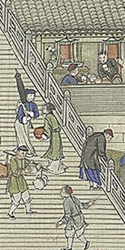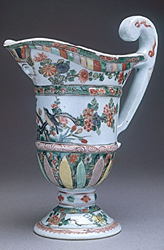
Maxwell K. Hearn, Consultant |
||||||||||||||||||||||||||||||||||||||||||||||||||||||||||||||||||||||||||||||||||||||||||||||||||||||||||||||||||||||||||||||||||||||||||||||||||||||||||||||
SCHOOLS OF ART DURING THE QING DYNASTY Art during the Qing dynasty was dominated by three major groups of artists. The first, sometimes called "the Individualists," was a group of men largely made up of loyalists to the fallen Ming dynasty. The Individualists referred to themselves as "leftover subjects of the Ming" and practiced a very personal form of art that sought to express their reaction to the Manchu conquest -- either a sense of resistance, reclusion, or sadness over the fall of the Ming dynasty. They often removed themselves not only from government circles but also from society, often by becoming Buddhist monks. The Individualists sought to express in their art their own feelings regarding the fall of the Ming dynasty and the conquest of China by a group of people whom they regarded as barbarians. These artists focused particularly on the expressive potential of painting and sought not to emulate past models so much as to use poetry, painting, and calligraphy in ways that would express their feelings of defiance and loss over the fall of the Ming dynasty. [Read more about "the Individualists" at The Metropolitan Museum of Art's Timeline of Art History.] A second group of Qing artists included those men who dedicated themselves to the preservation of Chinese traditional culture by returning to the careful study of a canon of earlier masters that had been defined in the 17th century. Their commitment to replicating and being inspired by this earlier canon of masterpieces led to the labeling of these artists as "the Orthodox school." The Orthodox masters made a point of first imitating these established earlier models and then trying to incorporate these stylistic traditions into their own work. They often created albums of paintings wherein each leaf would be devoted to the exposition of a specific earlier style. In this way, a particular album would demonstrate an individual's command over a whole range of earlier stylistic traditions. [Read more about traditionalists and "the Orthodox school" at The Metropolitan Museum of Art's Timeline of Art History.] A third group of Qing artists included commercial and court artists who specialized in large-scale decorative works. Such artists were employed by the imperial court to produce documentary, commemorative, and decorative works for the imperial palaces. Masters of technique, these artists drew upon the representational styles of the Song dynasty, when meticulously descriptive painting techniques were highly revered. [Read more about professional and court artists at The Metropolitan Museum of Art's Timeline of Art History.]
The Scholar-Artists Wang Hui and the Orthodox School of Painting | back to top |
CHINESE APPROACHES TO THE WORK OF ART Personal Expression Valued Over "Realism" The Importance of Poetry for Artists and Connoisseurs
The Work of Art as a Dialogue with the Past: The Role of Owners and Connoisseurs | back to top |
REPRESENTING SPACE AND THE EXTERNAL WORLD The painters of the Qing dynasty were inheritors of a tradition that was already more than a thousand years old. By the 13th century, Chinese artists had mastered the illusion of recession in space. But after this time, the representation of space and the description of the external world gradually ceased to be the principal objective of artists. Working on a flat surface -- such as a canvas or a scroll -- an artist faces the challenge of creating the illusion of three-dimensional forms on a two-dimensional surface. This is a problem for which artists both in the East and the West found solutions, but their solutions were very different. European painting after the 15th century tended to treat a painting as though the canvas were a window through which an illusionistic three-dimensional scene could be viewed; Chinese painting created the experience of space by means of a moving perspective that allowed the viewer's eye to explore the pictorial space from a shifting vantage point, so that, in the case of a long handscroll such as those chronicling an emperor's journey, space is experienced through the continuous unrolling of the work. European Approaches to Representing Space
Chinese Approaches to Representing Space | back to top |
INFLUENCE OF EUROPEAN ARTISTIC STYLES ON CHINESE PAINTING Beginning in the late 16th and early 17th centuries, European Jesuit missionaries began to enter China and serve at the imperial court. Many of these missionaries brought engravings, illustrated books, and paintings with them and it was through these visual materials that Chinese were first introduced to Western linear perspective and the use of shading to model forms as if they were illuminated by a single light source (called "chiaroscuro," an Italian word literally meaning "light-dark"). [See a charcoal drawing that uses chiaroscuro shading, by the 15th-century Italian artist Leonardo da Vinci, on The Metropolitan Museum of Art's Timeline of Art History.] The Chinese were impressed with the Europeans' techniques for creating the illusion of recession on a flat pictorial surface. This was particularly true in court circles, where emperors quickly realized the extent to which this new style of painting could serve well to commemorate and document their activities in a way that would be all the more powerful and convincing because of its realism. It is important to note, however, that even as "realistic" painting in the European style was very much in vogue at the Qing court, where it was appreciated for its documentary value, it was never regarded as "high art." Chinese art had long moved away from a representational style to one that privileged the personal expression of the individual artist over the representation of external appearances of nature. Comparing the Kangxi and Qianlong Tour Scrolls: The Influence of Giuseppe Castiglione and the European Style
The Qianlong Emperor's tour scrolls were begun in 1764 by the court artist Xu Yang (act. ca. 1750-after 1776), who was very much influenced by the European traditions of perspective and figural representation. Wang Hui, who began the Kangxi Emperor's tour scrolls in 1691, was one of the foremost painters of the Orthodox School, whose members dedicated themselves to the preservation of Chinese traditional culture by returning to the careful study of a canon of earlier Chinese masters. Thus, it is not surprising to compare the two sets of scrolls and find that they differ radically in their approach to the representation of space and the treatment of figures. A telling example is the comparison of two specific scrolls, the seventh scroll in the Kangxi Emperor's tour series and the sixth scroll in the Qianlong Emperor's tour series, which both feature the Grand Canal and the city of Suzhou. In the Kangxi scroll, Wang Hui's figures are painted in a stylized, almost cartoon-like style that gives them a tremendous amount of buoyancy and expressive energy. The figures in the Qianlong scroll, on the other hand, are handled in a more European style and are anatomically more accurate, but they look stiff and posed, as though they are frozen in space and time. Xu Yang's figures are more three-dimensional in their representation, and therefore more "realistic" than their counterparts by Wang Hui, but, paradoxically, they actually seem to have less animation and life than Wang Hui's figures. A comparison of the two artists' approaches to the representation of space in the tour scrolls reveals the limitations of translating the European style to the Chinese scroll format. Influenced by the Western technique of linear perspective, Xu Yang strives in the sixth Qianlong scroll to maintain a consistent vantage point in his representations of the Grand Canal and the route of the Qianlong Emperor into Suzhou. The Canal is presented as though the viewer were always looking from the east toward the west. But in order to maintain the consistency of this viewpoint, Xu Yang had to present Tiger Hill, one of the scenic highlights on this leg of the tour route, from the back rather than from the front, which would have been its characteristic and thus, more recognizable, view. In the seventh Kangxi scroll, on the other hand, Wang Hui had no problem reorienting the mountain to present it from its more characteristic frontal view, which is precisely the way a Chinese map maker would visualize a mountain. Xu Yang, in trying to maintain a consistent reference point based on linear perspective, could not reorient the mountain suddenly and show it from the other side. So again, as with the treatment of figures, the commitment to pictorial realism in fact became a limitation to the artist in significant ways. Though the European style added a certain kind of illusionary realism to the depiction of Qianlong's southern inspection tour, it could be argued that it also detracted from one of the most important functions of these scrolls as historical documents, which was to highlight the significance of the emperor's visit to important sites (such as Tiger Hill and the Grand Canal). [INTERACTIVE: See a detailed comparison of Wang Hui and Xu Yang's approaches to the representation of space in the inspection tour scrolls.] | back to top |
CHINESE ART IN EUROPE: PORCELAIN
One of the most important Chinese exports to Europe in the 17th century was porcelain, which had been invented in China about 1,000 years earlier. As European demand for Chinese porcelain grew (in part because European ceramic centers at this time did not possess the technical knowledge required to manufacture porcelain), porcelain from China, and later Japan, was by the 1630s flooding the Europe market. The Dutch alone were importing more than one million pieces per year. But in the 1680s, the Kangxi Emperor reasserted imperial control over the kilns at Jingdezhen in Jiangxi (an area renowned for having the finest clay and for producing porcelain fit for an emperor), and the export of Chinese porcelain to Europe came to a halt for a period of time. This interruption in supply led in part to renewed attempts at ceramic centers across Europe to unlock the "secret" to Chinese porcelain, which did happen eventually but not until early in the 18th century. Prior to this time Europeans could only copy the look of Chinese porcelain models and keep working to duplicate the translucent quality of Chinese porcelain. Today the term "Made in China" has gained a somewhat negative connotation as something that's an inexpensive imitation of "the real thing." Throughout the 17th and 18th centuries, however, the situation was quite the other way around when it came to porcelain. The European ceramics centers were far less sophisticated in their manufacturing techniques, and Chinese decorative arts had a huge influence on European tastes during this time. Porcelain Production in China | back to top | |
||||||||||||||||||||||||||||||||||||||||||||||||||||||||||||||||||||||||||||||||||||||||||||||||||||||||||||||||||||||||||||||||||||||||||||||||||||||||||||||




